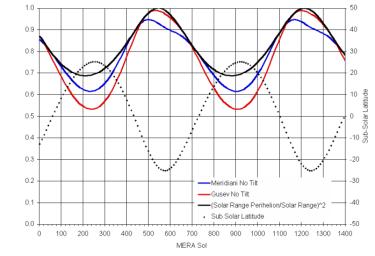
|
Solar Power on Mars
- Click the image above for a larger view
- Full-Res JPEG (911 x 623) (84.6 kB)
- Full-Res TIFF (911 x 623) (570.0 kB)
Caption:
This chart illustrates the variation in available solar power for each of NASA's twin Mars Exploration Rovers over the course of approximately two Mars years. Two factors affect the amount of available power: the tilt of Mars' axis and the eccentricity of the Mars' orbit about the sun.
The horizontal scale is the number of Martian days (sols) after the Jan. 4, 2004, (Universal Time) landing of Spirit at Mars' Gusev Crater. The vertical scale on the right indicates the amount of available solar power as a ratio of the amount available at the equator when Mars is closest to the sun (perihelion). The red line indicates power availability at Spirit's landing site (Gusev). The blue line indicates power availability at Opportunity's landing site (Meridiani).
The vertical scale on the right applies to the dotted line, indicating the latitude north or south of Mars' equator where the noon sun is overhead at different times of the Martian year.
Cataloging Keywords:
| Name | Value | Additional Values |
|---|---|---|
| Target | Mars | |
| System | ||
| Target Type | Planet | |
| Mission | Mars Exploration Rover (MER) | |
| Instrument Host | Opportunity (MER-B) | Spirit (MER-A) |
| Host Type | Rover | |
| Instrument | ||
| Detector | ||
| Extra Keywords | Color, Crater | |
| Acquisition Date | ||
| Release Date | 2005-12-05 | |
| Date in Caption | 2004-01-04 | |
| Image Credit | NASA/JPL-Caltech | |
| Source | photojournal.jpl.nasa.gov/catalog/PIA03607 | |
| Identifier | PIA03607 | |
